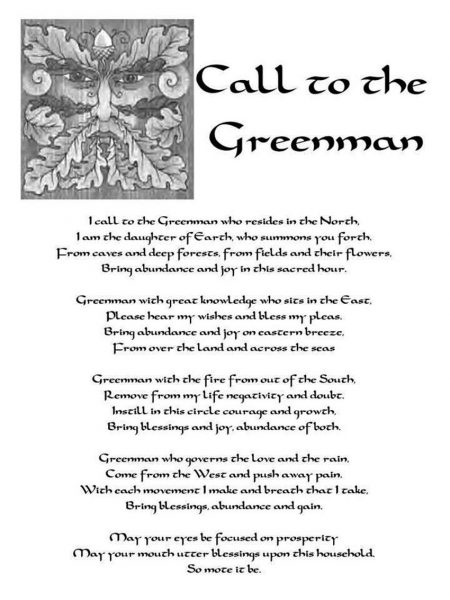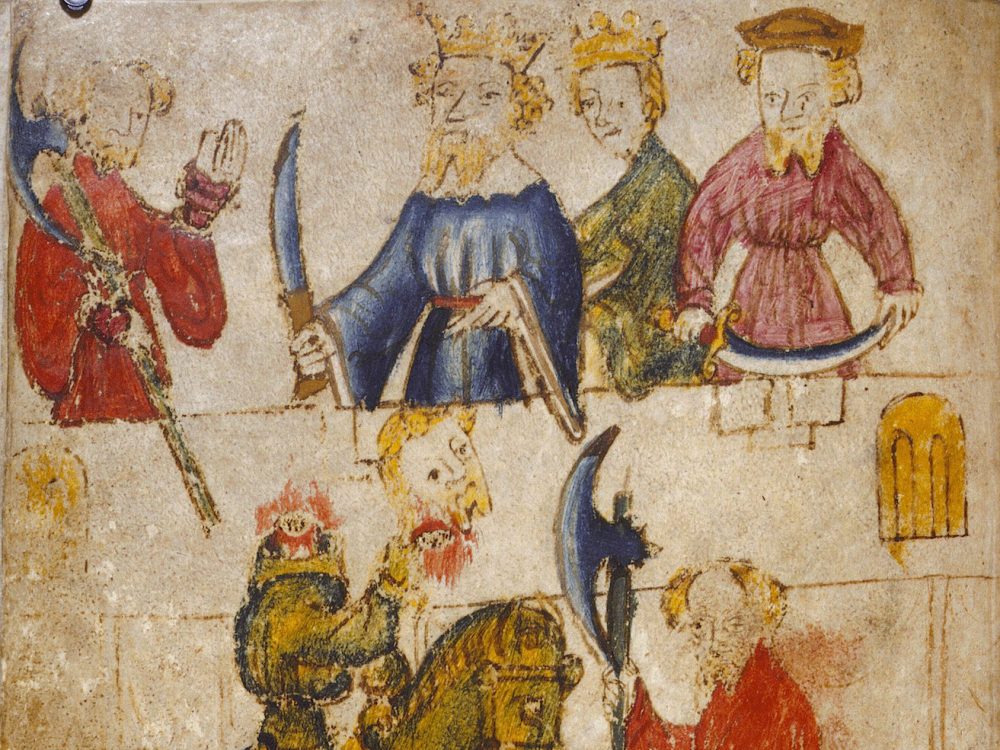More on Robin and the Green Man:
The mysterious yet omnipresent Green Man is already an icon. He links us with England’s pagan past and reminds us of our deep and sacred relationship with the natural history of these islands. He represent the spirit of the ancient forests, at once terrifying and protective, and the natural cycle of birth, death and rebirth.
As old as time himself, he has become a familiar image to us all. Adopted by medieval stonemasons, this elemental pagan image peers at us from the roof bosses and columns of hundreds of our oldest churches and from the T-shirts of young festival goers, a witness to the changes of centuries, yet as unchanging as the very earth from which he springs.
He is Jack-in-the-Green, Robin Hood, Herne The Hunter and the Celtic god Cernunnos. An icon for respect for our beautiful country and its past, but also perhaps a unifying champion for the coming environmental battle for its future.
T L Coltham
Sir Garwain and the Green Knight:
Learn More Here.
……………………………………………………………….
An Article on Robin Hood:
“Robin Hood was a species of fairy derived ultimately from the old Celtic and Saxon fertility god or vegetation deity, the so-called Green Man.
While in popular folklore Robin Hood was interchangeable with Green Robin , Robin of the Greenwood, Robin Goodfellow, Shakespeare’s Puck in A Midsummer Night’s Dream, who, at the summer solstice, presides over fertility, sexuality and nuptials.
The Robin Hood legend provided, in effect, a handy guise whereby the fertility rites of ancient paganism were introduced back into the bosom of nominally Christian Britain. Every May Day, there would be a festival of unabashed pagan origin.
Rituals would be enacted around the May Pole, traditional symbol of the archaic goddess of sexuality and fertility. On Midsummer’s Day, every village virgin would become, metaphorically, Queen of the May.
Many of them would be ushered into the greenwood where they would undergo their sexual initiation at the hands of a youth playing the role of Robin Hood or Robin Greenfellow, while Friar Tuck, the Abbot of unreason, would officiate, blessing the mating couples in a parody of formal nuptials. By virtue of such role-playing, the borders separating dramatic masque and fertility ritual would effectively dissolve.
May Day would be, in fact, a day of orgy. Nine months later, it would produce,
throughout the British Isles, its annual crop of children.”
(From the temple and the lodge, by Michail Baigent and Richard Leigh).
The Holly King as a Green Man
The Holly King.
The Holly King is a speculated archetype of English folklore, who has been popularised in some Neopagan traditions. Robert
Graves proposed in The White Goddess that two mythical figures, the Holly King and the Oak King, representing two halves of the year, perpetually strive for superiority, the Holly King triumphing over the Oak King at midwinter and the Oak King triumphing in turn at midsummer.
Graves identified a number of paired hero-figures who he felt were variants on this myth, including Lleu Llaw Gyffes and Gronw Pebr, Gwyn and Gwythr, Lugh and Balor, Balan and
Balin, Gawain and the Green Knight, the robin and the wren, and
even Jesus and John the Baptist.
These pairs are seen as the dual aspects of the male Earth deity, one strong in the summer, the other strong in the winter.
Stewart and Janet Farrar, following Graves’ theory, gave a similar interpretation to Wiccan seasonal rituals. According to Joanne Pearson, the Holly King is represented by holly and
other evergreens, and personifies the dark half of the Wiccan Wheel
of the Year. He is also seen by some Neopagans as an early inspiration for the Santa Claus legend.
The Green Man: Ash Mandrake & Friends.
The Green Man: Type O Negative.
Call to the Green Man Poem:

(Paganesque)
Magpie Lane: Jack in the Green/Jacks Alive.
An Article by Kathleen Minton at the Spirit of the Green Man Studio at Tintern, Wales:
ABOUT THE GREEN MAN. PART 1: How Did He Get His Name:
So we start a journey this new year into an exploration of the Green Man.
Many people are surprised when they find out his actual name “Green Man” only appeared first in 1939.
Not far from our shop in Tintern lies Llangwym, a rural village of Monmouthshire.
In the 1930’s the then vicar, a Reverend Griffith of St Jerome’s Church
was intrigued by the carvings of the so called “Foliage Man” to be found in
churches and cathedrals in Britain and Europe.
In addition to this, he also had a interest in ancient folklore.
He was introduced to the then Lady Raglan, who was later to become a
renown authority on the the “Foliate” or “Green Man”.
These two individuals had differing opinions on the meaning of this character.
Rev. Griffiths thought he symbolised a “Spirit of Inspiration”. However Lady Raglan
strongly thought he was a man and not a supernatural spirit, in her thought he
was a “Green Man” and so she gave him the name by which we know him today.
Lady Raglan deeply researched our native folklore and was surprised how
the same foliage figure appeared time after time in our celebrations, such as May Day.
Here a male would be dressed in foliage and leaves, complete with antlers and a mask of leaves.
He would lead a procession with his May Queen through the villages to the May Pole for the jovial celebrations,
thought to be associated with fertility.
There is no doubt that these pagan traditions were frowned upon by some
elements of the church, despite this quite a few of the rural
small villages still held on to these celebrations, so they never really died out.
Think of the many celebrations we have today for May Day
and other local events featuring these mystical pagan beings
and not forgetting the fabulous Morris Men gatherings mostly connected to nature and the calendar.
This is just a beginning to our little journey together, so in summary
Lady Raglans conclusion in a magazine publication stated:
“The question is whether there was any figure in real life from which it could have been taken.
The answer, I think, is there is only one of sufficient importance, the figure known as the
Green Man, Jack in the Green,Robin Hood, The king of the May and the Garland,
Who is the central figure in the May Day celebrations throughout northern and Central Europe”.
5.1.23
